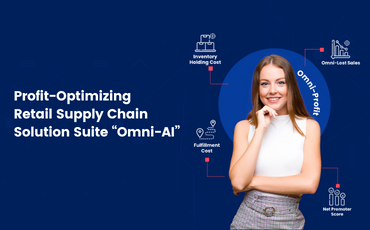
Omni-Channel and Retail KPIs: The Good, the Bad and the Future
To gain marketplace advantage, many retailers have adopted an omni-channel strategy in a bid to both make shopping easier for customers as well as fulfilling demand more quickly and conveniently.
The strategy entails broadening sales channels, unifying the customer experience across channels, and harnessing the supply chain to deliver product through multiple paths and locations. To fully realize marketplace advantage, retailer omni-channel skills must evolve:
- From transactional competency (systems and processes deliver what is expected).
- To economically sound (can the platform be measured & managed profitably).
- To competitively leverageable (does the capability deliver competitive advantage).
After an initial flurry of activity, many retailers have attained stage 1 (transactional competency). They can deliver an omni-channel sales experience to the customer and have enabled their supply chain to deliver product in a multitude of ways. But many are struggling on stage 2, making the platform economically sound, which is a requirement to attain stage 3 (competitive leverage).
Let’s examine some of the challenges in moving from stage 1 (transactional competency) to stage 2 (economic soundness).
First, let’s talk about the nature of the change. To use an analogy, the communications industry made a similar change 40 years ago. Prior, telecommunications were point-to-point (PTP) needing a single circuit to send data or complete a call. In the late 1970’s another approach came into being. It was the internet protocol (IP) and it worked in an entirely different way. It packetized communication information and dynamically routed the packets through different paths reassembling them at the end. As a result, the transport mechanism changed from point-to-point to a network infrastructure.
How is this change in telecommunications like the change to omni-channel retailing?
In the traditional model, we pretty much had a linear, point-to-point distribution system. Product flowed from a manufacturer to a DC then to a store where a customer went to purchase it. Essentially a series of nodes. And measurement and management of that linear flow devolved into measuring and managing each node in the chain. And it was easy to link system/chain performance to that of the nodes.
In the move to omni-channel retail, we’ve moved from linear flows to a network fulfillment model. The fact that product can flow from many places to many places means that we have enhanced our ability to serve the customer with our existing inventory. That was the philosophical underpinning of omni-channel (on the supply chain side) that was most attractive - making tighter inventory seem bigger by putting it into motion and leveraging it more broadly.
The problem facing many retailers today is that those capabilities do not come for free. Essentially, meeting the economically sound challenge means being able to holistically measure and manage the NETWORK not just the nodes in the network. And that is proving to be difficult for many retailers.
So, what do KPI’s have to do with it? For many retailers KPI’s define both how they measure and how they manage the business. People are trained to track KPI’s and, when they fall out of range, take corrective action. The fact that many KPI’s can be localized has enabled the distribution of management responsibilities to both specific business units as well as functional areas.
With the arrival of basic omni-channel capabilities, we need to ask whether our historical KPI’s provide with the perspectives to effectively manage the supply chain. How well our KPI’s help us manage an omni-channel supply chain depend on two key questions:
- Are our KPIs complete?
- Can our KPIs be expressed in a common metric?
Completeness
What do we mean by “completeness?” A complete set of KPIs address ALL drivers of total performance.
A complete set of KPIs measures all factors that impact the financial performance of a retailer.
Relative to a specific business decision, we don’t always need to address every factor that drives financial performance. Many are fixed costs that aren’t directly affected by the decision. But we do need to address ALL costs that are impacted by the decision if we want to completely understand the ramifications of our decisions (and plans that support those decisions).
Historically, for inventory purposes, retailers focused on two key KPIs representing customer service (e.g. in-stock, service level…) and financial efficiency (turn, sell-through…). Certainly, other factors are required for “completeness” such as labor cost and transportation but, for most retailers, these are “fixed” costs and not directly linked to unitary inventory decisions. As a result, retailers generally manage those costs as system costs separate from the inventory decision and focused on customer service and inventory efficiency as they two key KPI’s to manage their inventory levels.
How has omni-channel impacted the requirement of “completeness?” One of the key tactics of omni-channel is inventory “from-anywhere-to-anywhere” which essentially makes inventory very mobile – at a cost. Unlike the traditional brick-and-mortar transportation cost (DC to Store, for example) which was managed as a fixed, system cost, the omni-channel “from-anywhere-to-anywhere” logistics cost is at the item level and is a variable transactional cost.
So, to be complete, we need to explicitly account for that transportation cost. And we need to do so both in our planning (where & when to place inventory) and fulfillment (where to pull inventory from to service a sale) decisions.
Common Metric
Once we have identified a complete set of KPI’s that address all of the impacts of our inventory decision, the next challenge is how we measure them. Here’s where traditional KPI’s, even for traditional brick-and-mortar retail, come up short. Let’s consider the two key KPIs that retailers have traditionally used to measure inventory:
1. Inventory fulfillment of customer demand. This can be expressed in several ways: in-stock, service level, demand fulfillment. All are designed to measure how well the inventory is serving the customer.
2. Inventory financial efficiency. For long-life replenishment products, this is often defined as inventory turn. For shorter-life items, a sell-through percentage is often used to measure inventory efficiency. Both measures are designed to express how well the inventory is performing financially.
In looking at these two metrics, one immediately notes there is no easy way to trade-off between the two KPI’s. A retailer cannot easily answer the question “If I raise turn from 3 to 3.5, what happens to in-stock?” Not only is it difficult to answer this question, the two concepts don’t even share a common measurement regime.
Omni-channel compounds this problem in many ways. First, by putting inventory into motion at a transactional/granular level, omni-shipping costs is an added factor that must be considered. And that factor needs a seat at the KPI table. Second, how do we now measure the customer service for a level of inventory at a location if our fulfillment model says we can satisfy demand with “inventory from-anywhere-to-anywhere?”
So, let’s recap what our KPI’s have become in this omni-world. There is a KPI for customer service that is a %. There is a KPI for inventory financial efficiency (turn) and that is a number. And, finally, there is a KPI for omni-logistics cost and that is in $’s. If we can’t easily answer the “If I raise turn from 3 to 3.5” question, the questions omni-channel raises are even more difficult to solve without some significant changes.
So, how have retailers balanced KPIs in the past? Basically, through a combination of trial-and-error and the development of an empirical memory of what worked and didn’t. While there are many sophisticated tools that retailers have used, at their root, the tools asked to retailer to answer the question “What service level should we target?” and that answer was based on past experience and retailer knowledge.
The Future
The problem facing retailers today, and into the future, is that the approach of the past is too slow, too cumbersome, and too imprecise for the complexity that omni-channel creates. No longer can they make in-market changes to measure their impact and develop an experience base to drive their policies.
The omni-supply chain problem is more complex to analyze, measure and manage. In addition to traditional customer service and inventory productivity challenges, many retailers now face omni-logistics costs in the 1000s of basis points (in the order of 10% of sales or more). With “from-anywhere-to-anywhere” as a fulfillment framework, the analytical challenge is daunting. Altogether, it’s not your parents supply chain.
So, how can retailers solve this problem and move to a better future? I’d propose these key steps:
1. Strategy
- Move quickly focusing on improving decision quality as they impact financial performance
- Leverage existing transactional systems to reduce risk and shorten development time
- Be willing to re-conceive the roles of people and systems
2. Analytics
- Understand ALL factors that impact costs and be sure to incorporate their measures into reporting, models, and decisions
- Convert these factors to a common measurement regime – specifically economic measures. Use an economic measure of customer service (e.g., lost margin dollars), use an economic measure of inventory efficiency (e.g., inventory holding cost), and variable fulfillment costs to convert all KPIs into economic terms.
- With financially expressed KPIs, leverage advanced analytics and optimization approaches to enable measuring and modeling total system costs. Use that cost model to economically optimize TOTAL costs and drive improved profitability.
3. Systems
- Move to a layered architecture segregating transactional activities from decision activities.
- Implement strong change control for core transactional systems. Focus on bullet-proof reliability.
- Focus on speed and flexibility for decision systems. Ensure that they can quickly respond to changing business models and requirements.

By adopting a profit framework, where:
Omni Profit = Expected Sales - Lost Margin - Cost of Inventory (average or leftover) - Fulfillment costs
retailers not only create a measurable omni-channel framework but put into place a financial infrastructure that will flexibly guide them in quickly evolving their supply chain and create an economically sound omni-channel driven business.
Those that do are also more likely to gain competitive advantage as they move forward.
Interested in learning how we can help you start winning in the omni-future? If so, get in touch with us today.






